Financial Resources Management: Sources and Implications
VerifiedAdded on 2020/01/28
|20
|6193
|58
Report
AI Summary
This report comprehensively examines financial resource management, focusing on the sources of finance for both incorporated and unincorporated businesses, including sole proprietorships, partnerships, and registered companies. It assesses the implications of various funding sources, such as owner's funds, loans from relatives, bank loans, and the issuance of equity shares, preference shares, and debentures. The report analyzes the costs associated with different financing options, considering factors like tax, dividends, and interest, while also highlighting the benefits of financial planning. Furthermore, it explores the financial impact of various investment scenarios, including takeovers financed by partners, finance brokers, and venture capitalists, as well as the impact on financial statements. The report includes a cash budget analysis for Clariton Antiques Limited, along with recommendations for costing and pricing models. Finally, it provides a comparative analysis of financial statements, contrasting those of Clariton Antiques Limited with those of sole proprietorships and partnerships, while also comparing the company's financial performance over time.

MANAGEMENT OF FINANCIAL RESOURCES
STUDENT NAME:
STUDENT ID:
PROFESSOR NAME:
1
STUDENT NAME:
STUDENT ID:
PROFESSOR NAME:
1
Paraphrase This Document
Need a fresh take? Get an instant paraphrase of this document with our AI Paraphraser

Table of Contents
Introduction......................................................................................................................................3
Task 1...............................................................................................................................................3
1.1 Identification of the sources of finance to the incorporated and the unincorporated business.3
1.2 Assessing the implications of the sources of finance................................................................7
1.3 Identify the most suitable source of finance for the company Clariton Antiques Limited......11
Task 2.............................................................................................................................................11
2.1 Analysing the costs of the two sources of finance considering the factors of Tax, Dividends
and Interest.....................................................................................................................................11
2.2 Explaining the benefits of financial planning for the entity Clariton Antiques Limited.........12
2.3 Explain the financial impact on the firm if the takeover is financed by the Partners, Finance
Broker and the Venture Capitalists................................................................................................12
2.4 Explaining the impact of financial statement if the project is financed by the Venture
Capitalists and the Finance Broker................................................................................................13
Task 3.1 Preparing and analysing the cash budget for Clariton Antiques....................................13
Task 3.2 Select an appropriate costing method for the organisation Claritin Antiques Limited and
also draft a suitable pricing model for the entity...........................................................................14
Task 3.3 Based on the capital budgeting techniques make a selection between the projects based
on the given data............................................................................................................................15
Task 4.............................................................................................................................................16
4.1 Describe the components of financial statements....................................................................16
4.2 Comparison of the financial statements of Clariton Antiques Limited with the financial
statements of a sole proprietary concern and a partnership firm...................................................17
4.3 Facilitate a comparison of the financial statements of the company in the current year with
that of the previous year................................................................................................................18
Conclusion.....................................................................................................................................19
Reference List:...............................................................................................................................20
2
Introduction......................................................................................................................................3
Task 1...............................................................................................................................................3
1.1 Identification of the sources of finance to the incorporated and the unincorporated business.3
1.2 Assessing the implications of the sources of finance................................................................7
1.3 Identify the most suitable source of finance for the company Clariton Antiques Limited......11
Task 2.............................................................................................................................................11
2.1 Analysing the costs of the two sources of finance considering the factors of Tax, Dividends
and Interest.....................................................................................................................................11
2.2 Explaining the benefits of financial planning for the entity Clariton Antiques Limited.........12
2.3 Explain the financial impact on the firm if the takeover is financed by the Partners, Finance
Broker and the Venture Capitalists................................................................................................12
2.4 Explaining the impact of financial statement if the project is financed by the Venture
Capitalists and the Finance Broker................................................................................................13
Task 3.1 Preparing and analysing the cash budget for Clariton Antiques....................................13
Task 3.2 Select an appropriate costing method for the organisation Claritin Antiques Limited and
also draft a suitable pricing model for the entity...........................................................................14
Task 3.3 Based on the capital budgeting techniques make a selection between the projects based
on the given data............................................................................................................................15
Task 4.............................................................................................................................................16
4.1 Describe the components of financial statements....................................................................16
4.2 Comparison of the financial statements of Clariton Antiques Limited with the financial
statements of a sole proprietary concern and a partnership firm...................................................17
4.3 Facilitate a comparison of the financial statements of the company in the current year with
that of the previous year................................................................................................................18
Conclusion.....................................................................................................................................19
Reference List:...............................................................................................................................20
2
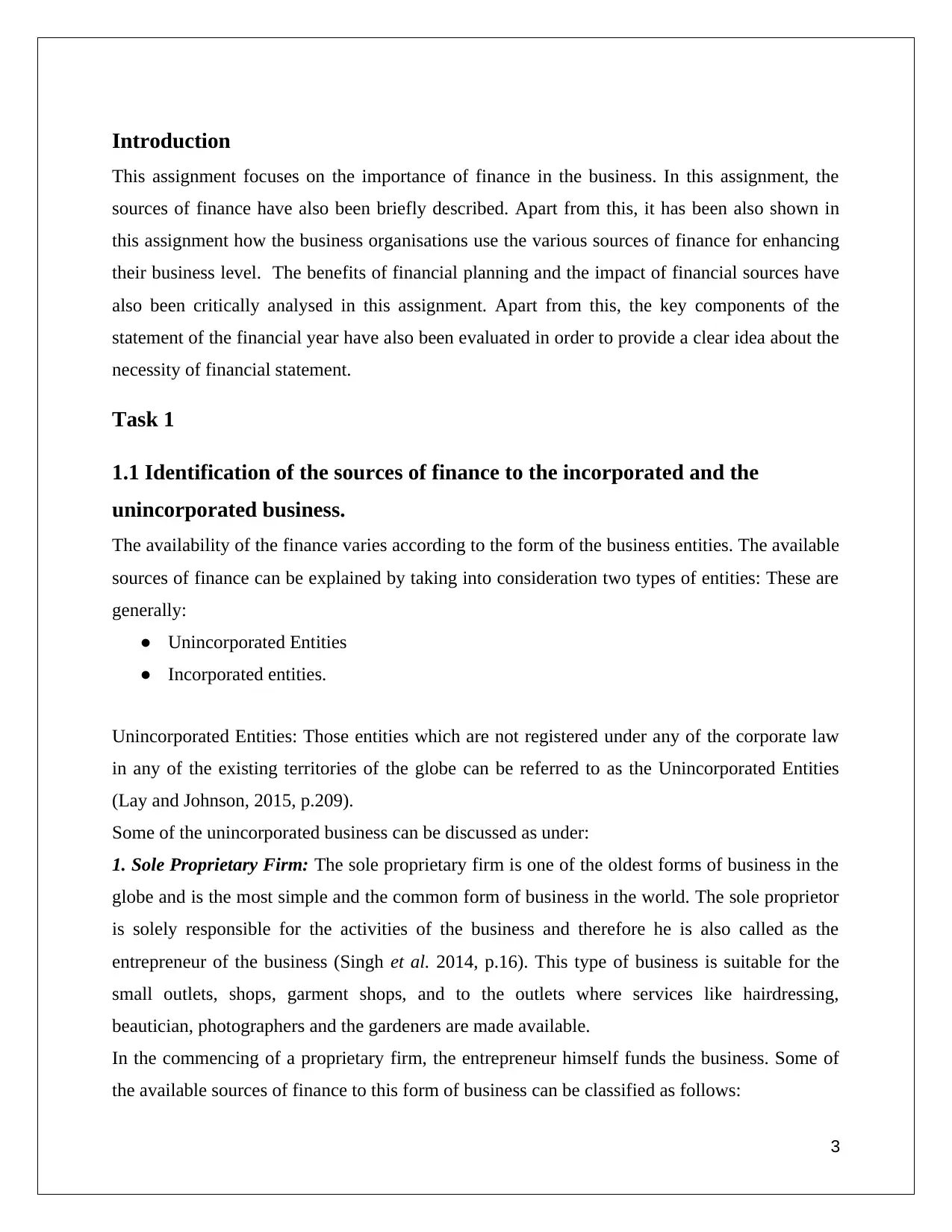
Introduction
This assignment focuses on the importance of finance in the business. In this assignment, the
sources of finance have also been briefly described. Apart from this, it has been also shown in
this assignment how the business organisations use the various sources of finance for enhancing
their business level. The benefits of financial planning and the impact of financial sources have
also been critically analysed in this assignment. Apart from this, the key components of the
statement of the financial year have also been evaluated in order to provide a clear idea about the
necessity of financial statement.
Task 1
1.1 Identification of the sources of finance to the incorporated and the
unincorporated business.
The availability of the finance varies according to the form of the business entities. The available
sources of finance can be explained by taking into consideration two types of entities: These are
generally:
● Unincorporated Entities
● Incorporated entities.
Unincorporated Entities: Those entities which are not registered under any of the corporate law
in any of the existing territories of the globe can be referred to as the Unincorporated Entities
(Lay and Johnson, 2015, p.209).
Some of the unincorporated business can be discussed as under:
1. Sole Proprietary Firm: The sole proprietary firm is one of the oldest forms of business in the
globe and is the most simple and the common form of business in the world. The sole proprietor
is solely responsible for the activities of the business and therefore he is also called as the
entrepreneur of the business (Singh et al. 2014, p.16). This type of business is suitable for the
small outlets, shops, garment shops, and to the outlets where services like hairdressing,
beautician, photographers and the gardeners are made available.
In the commencing of a proprietary firm, the entrepreneur himself funds the business. Some of
the available sources of finance to this form of business can be classified as follows:
3
This assignment focuses on the importance of finance in the business. In this assignment, the
sources of finance have also been briefly described. Apart from this, it has been also shown in
this assignment how the business organisations use the various sources of finance for enhancing
their business level. The benefits of financial planning and the impact of financial sources have
also been critically analysed in this assignment. Apart from this, the key components of the
statement of the financial year have also been evaluated in order to provide a clear idea about the
necessity of financial statement.
Task 1
1.1 Identification of the sources of finance to the incorporated and the
unincorporated business.
The availability of the finance varies according to the form of the business entities. The available
sources of finance can be explained by taking into consideration two types of entities: These are
generally:
● Unincorporated Entities
● Incorporated entities.
Unincorporated Entities: Those entities which are not registered under any of the corporate law
in any of the existing territories of the globe can be referred to as the Unincorporated Entities
(Lay and Johnson, 2015, p.209).
Some of the unincorporated business can be discussed as under:
1. Sole Proprietary Firm: The sole proprietary firm is one of the oldest forms of business in the
globe and is the most simple and the common form of business in the world. The sole proprietor
is solely responsible for the activities of the business and therefore he is also called as the
entrepreneur of the business (Singh et al. 2014, p.16). This type of business is suitable for the
small outlets, shops, garment shops, and to the outlets where services like hairdressing,
beautician, photographers and the gardeners are made available.
In the commencing of a proprietary firm, the entrepreneur himself funds the business. Some of
the available sources of finance to this form of business can be classified as follows:
3
⊘ This is a preview!⊘
Do you want full access?
Subscribe today to unlock all pages.

Trusted by 1+ million students worldwide
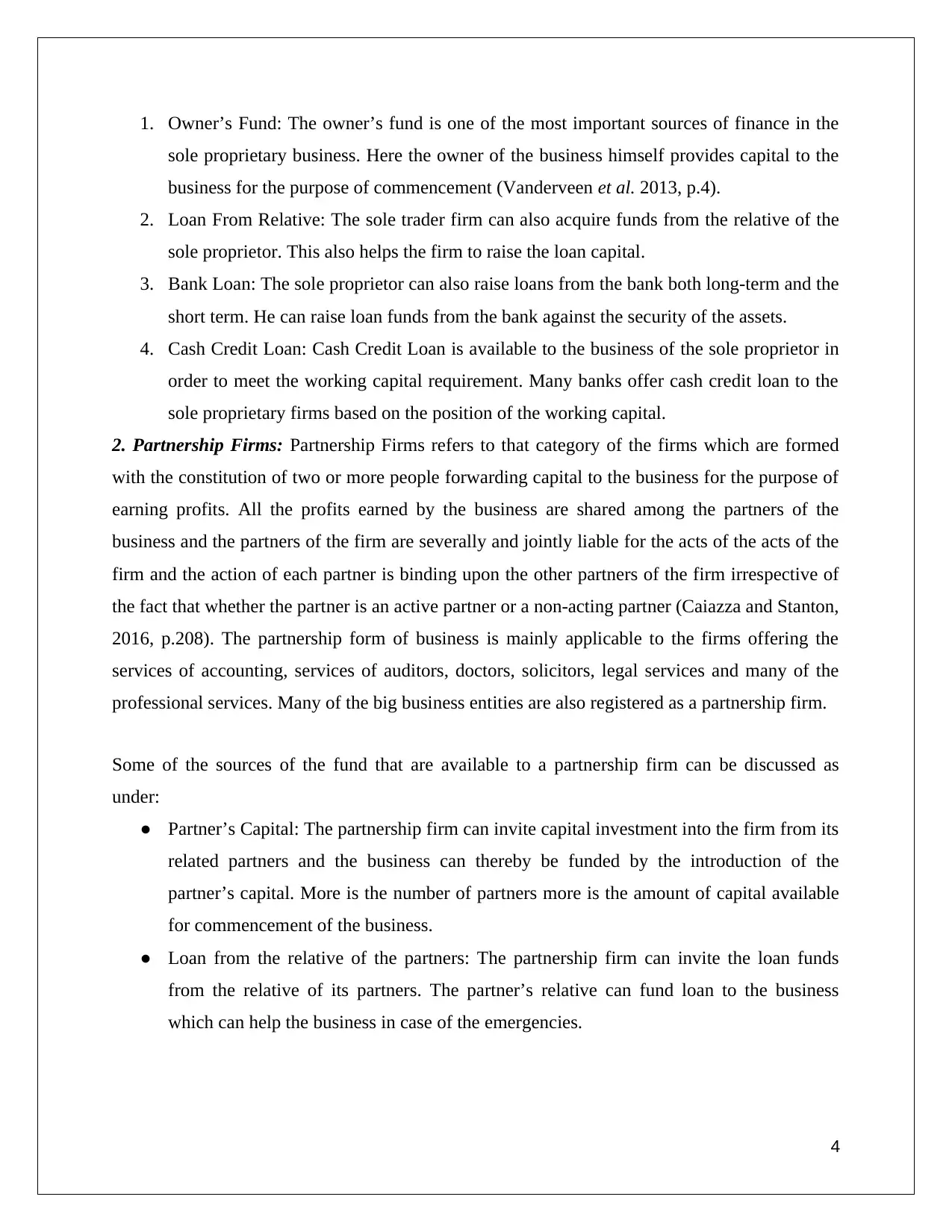
1. Owner’s Fund: The owner’s fund is one of the most important sources of finance in the
sole proprietary business. Here the owner of the business himself provides capital to the
business for the purpose of commencement (Vanderveen et al. 2013, p.4).
2. Loan From Relative: The sole trader firm can also acquire funds from the relative of the
sole proprietor. This also helps the firm to raise the loan capital.
3. Bank Loan: The sole proprietor can also raise loans from the bank both long-term and the
short term. He can raise loan funds from the bank against the security of the assets.
4. Cash Credit Loan: Cash Credit Loan is available to the business of the sole proprietor in
order to meet the working capital requirement. Many banks offer cash credit loan to the
sole proprietary firms based on the position of the working capital.
2. Partnership Firms: Partnership Firms refers to that category of the firms which are formed
with the constitution of two or more people forwarding capital to the business for the purpose of
earning profits. All the profits earned by the business are shared among the partners of the
business and the partners of the firm are severally and jointly liable for the acts of the acts of the
firm and the action of each partner is binding upon the other partners of the firm irrespective of
the fact that whether the partner is an active partner or a non-acting partner (Caiazza and Stanton,
2016, p.208). The partnership form of business is mainly applicable to the firms offering the
services of accounting, services of auditors, doctors, solicitors, legal services and many of the
professional services. Many of the big business entities are also registered as a partnership firm.
Some of the sources of the fund that are available to a partnership firm can be discussed as
under:
● Partner’s Capital: The partnership firm can invite capital investment into the firm from its
related partners and the business can thereby be funded by the introduction of the
partner’s capital. More is the number of partners more is the amount of capital available
for commencement of the business.
● Loan from the relative of the partners: The partnership firm can invite the loan funds
from the relative of its partners. The partner’s relative can fund loan to the business
which can help the business in case of the emergencies.
4
sole proprietary business. Here the owner of the business himself provides capital to the
business for the purpose of commencement (Vanderveen et al. 2013, p.4).
2. Loan From Relative: The sole trader firm can also acquire funds from the relative of the
sole proprietor. This also helps the firm to raise the loan capital.
3. Bank Loan: The sole proprietor can also raise loans from the bank both long-term and the
short term. He can raise loan funds from the bank against the security of the assets.
4. Cash Credit Loan: Cash Credit Loan is available to the business of the sole proprietor in
order to meet the working capital requirement. Many banks offer cash credit loan to the
sole proprietary firms based on the position of the working capital.
2. Partnership Firms: Partnership Firms refers to that category of the firms which are formed
with the constitution of two or more people forwarding capital to the business for the purpose of
earning profits. All the profits earned by the business are shared among the partners of the
business and the partners of the firm are severally and jointly liable for the acts of the acts of the
firm and the action of each partner is binding upon the other partners of the firm irrespective of
the fact that whether the partner is an active partner or a non-acting partner (Caiazza and Stanton,
2016, p.208). The partnership form of business is mainly applicable to the firms offering the
services of accounting, services of auditors, doctors, solicitors, legal services and many of the
professional services. Many of the big business entities are also registered as a partnership firm.
Some of the sources of the fund that are available to a partnership firm can be discussed as
under:
● Partner’s Capital: The partnership firm can invite capital investment into the firm from its
related partners and the business can thereby be funded by the introduction of the
partner’s capital. More is the number of partners more is the amount of capital available
for commencement of the business.
● Loan from the relative of the partners: The partnership firm can invite the loan funds
from the relative of its partners. The partner’s relative can fund loan to the business
which can help the business in case of the emergencies.
4
Paraphrase This Document
Need a fresh take? Get an instant paraphrase of this document with our AI Paraphraser
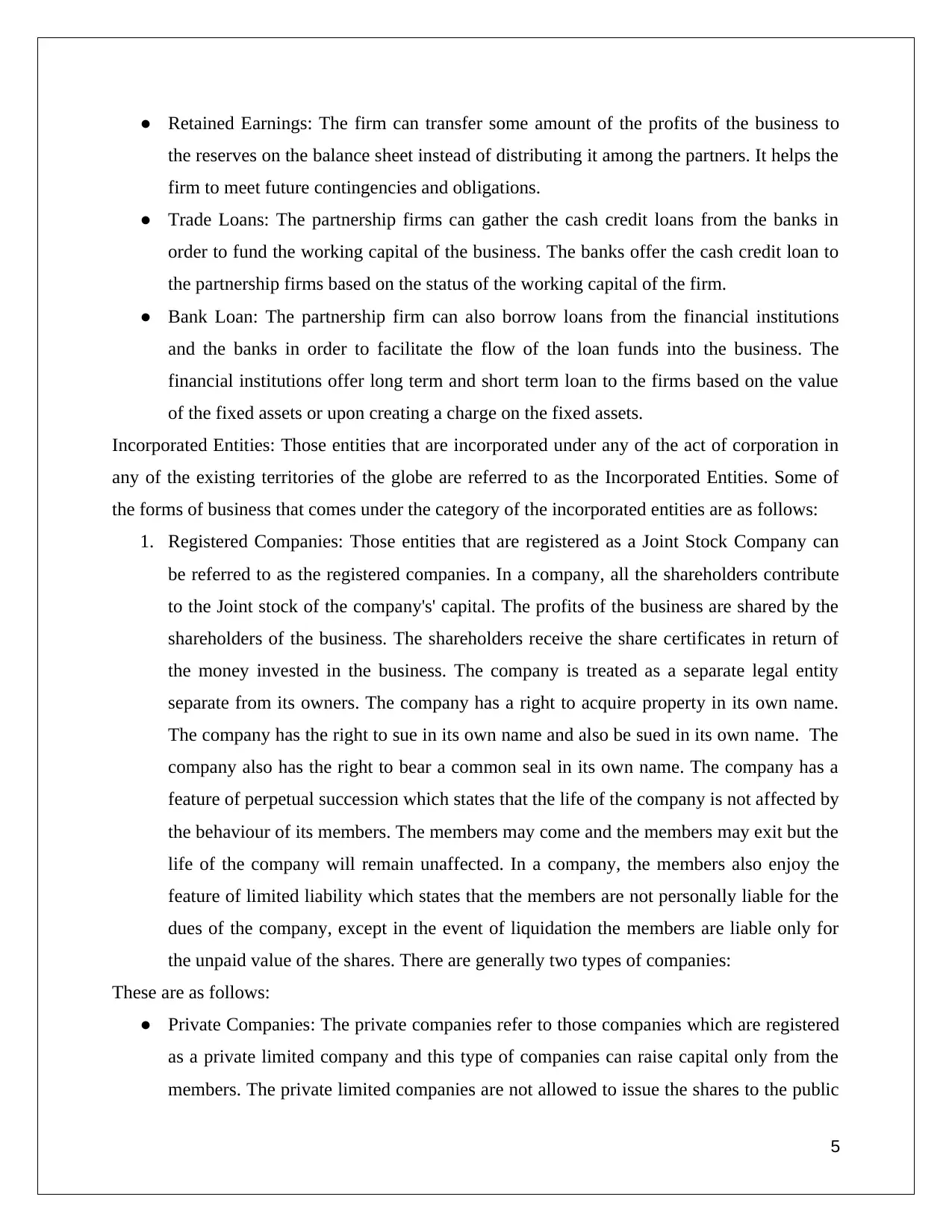
● Retained Earnings: The firm can transfer some amount of the profits of the business to
the reserves on the balance sheet instead of distributing it among the partners. It helps the
firm to meet future contingencies and obligations.
● Trade Loans: The partnership firms can gather the cash credit loans from the banks in
order to fund the working capital of the business. The banks offer the cash credit loan to
the partnership firms based on the status of the working capital of the firm.
● Bank Loan: The partnership firm can also borrow loans from the financial institutions
and the banks in order to facilitate the flow of the loan funds into the business. The
financial institutions offer long term and short term loan to the firms based on the value
of the fixed assets or upon creating a charge on the fixed assets.
Incorporated Entities: Those entities that are incorporated under any of the act of corporation in
any of the existing territories of the globe are referred to as the Incorporated Entities. Some of
the forms of business that comes under the category of the incorporated entities are as follows:
1. Registered Companies: Those entities that are registered as a Joint Stock Company can
be referred to as the registered companies. In a company, all the shareholders contribute
to the Joint stock of the company's' capital. The profits of the business are shared by the
shareholders of the business. The shareholders receive the share certificates in return of
the money invested in the business. The company is treated as a separate legal entity
separate from its owners. The company has a right to acquire property in its own name.
The company has the right to sue in its own name and also be sued in its own name. The
company also has the right to bear a common seal in its own name. The company has a
feature of perpetual succession which states that the life of the company is not affected by
the behaviour of its members. The members may come and the members may exit but the
life of the company will remain unaffected. In a company, the members also enjoy the
feature of limited liability which states that the members are not personally liable for the
dues of the company, except in the event of liquidation the members are liable only for
the unpaid value of the shares. There are generally two types of companies:
These are as follows:
● Private Companies: The private companies refer to those companies which are registered
as a private limited company and this type of companies can raise capital only from the
members. The private limited companies are not allowed to issue the shares to the public
5
the reserves on the balance sheet instead of distributing it among the partners. It helps the
firm to meet future contingencies and obligations.
● Trade Loans: The partnership firms can gather the cash credit loans from the banks in
order to fund the working capital of the business. The banks offer the cash credit loan to
the partnership firms based on the status of the working capital of the firm.
● Bank Loan: The partnership firm can also borrow loans from the financial institutions
and the banks in order to facilitate the flow of the loan funds into the business. The
financial institutions offer long term and short term loan to the firms based on the value
of the fixed assets or upon creating a charge on the fixed assets.
Incorporated Entities: Those entities that are incorporated under any of the act of corporation in
any of the existing territories of the globe are referred to as the Incorporated Entities. Some of
the forms of business that comes under the category of the incorporated entities are as follows:
1. Registered Companies: Those entities that are registered as a Joint Stock Company can
be referred to as the registered companies. In a company, all the shareholders contribute
to the Joint stock of the company's' capital. The profits of the business are shared by the
shareholders of the business. The shareholders receive the share certificates in return of
the money invested in the business. The company is treated as a separate legal entity
separate from its owners. The company has a right to acquire property in its own name.
The company has the right to sue in its own name and also be sued in its own name. The
company also has the right to bear a common seal in its own name. The company has a
feature of perpetual succession which states that the life of the company is not affected by
the behaviour of its members. The members may come and the members may exit but the
life of the company will remain unaffected. In a company, the members also enjoy the
feature of limited liability which states that the members are not personally liable for the
dues of the company, except in the event of liquidation the members are liable only for
the unpaid value of the shares. There are generally two types of companies:
These are as follows:
● Private Companies: The private companies refer to those companies which are registered
as a private limited company and this type of companies can raise capital only from the
members. The private limited companies are not allowed to issue the shares to the public
5
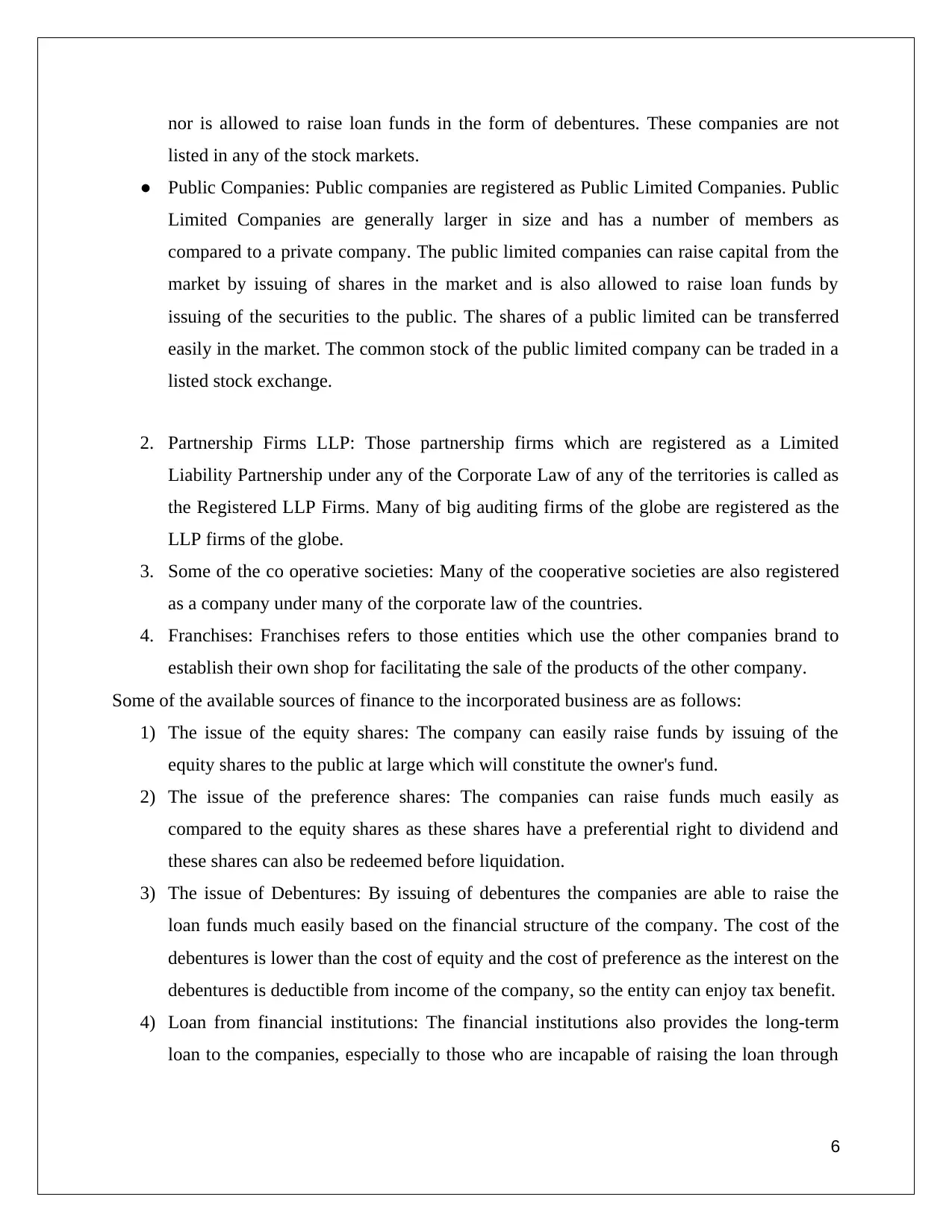
nor is allowed to raise loan funds in the form of debentures. These companies are not
listed in any of the stock markets.
● Public Companies: Public companies are registered as Public Limited Companies. Public
Limited Companies are generally larger in size and has a number of members as
compared to a private company. The public limited companies can raise capital from the
market by issuing of shares in the market and is also allowed to raise loan funds by
issuing of the securities to the public. The shares of a public limited can be transferred
easily in the market. The common stock of the public limited company can be traded in a
listed stock exchange.
2. Partnership Firms LLP: Those partnership firms which are registered as a Limited
Liability Partnership under any of the Corporate Law of any of the territories is called as
the Registered LLP Firms. Many of big auditing firms of the globe are registered as the
LLP firms of the globe.
3. Some of the co operative societies: Many of the cooperative societies are also registered
as a company under many of the corporate law of the countries.
4. Franchises: Franchises refers to those entities which use the other companies brand to
establish their own shop for facilitating the sale of the products of the other company.
Some of the available sources of finance to the incorporated business are as follows:
1) The issue of the equity shares: The company can easily raise funds by issuing of the
equity shares to the public at large which will constitute the owner's fund.
2) The issue of the preference shares: The companies can raise funds much easily as
compared to the equity shares as these shares have a preferential right to dividend and
these shares can also be redeemed before liquidation.
3) The issue of Debentures: By issuing of debentures the companies are able to raise the
loan funds much easily based on the financial structure of the company. The cost of the
debentures is lower than the cost of equity and the cost of preference as the interest on the
debentures is deductible from income of the company, so the entity can enjoy tax benefit.
4) Loan from financial institutions: The financial institutions also provides the long-term
loan to the companies, especially to those who are incapable of raising the loan through
6
listed in any of the stock markets.
● Public Companies: Public companies are registered as Public Limited Companies. Public
Limited Companies are generally larger in size and has a number of members as
compared to a private company. The public limited companies can raise capital from the
market by issuing of shares in the market and is also allowed to raise loan funds by
issuing of the securities to the public. The shares of a public limited can be transferred
easily in the market. The common stock of the public limited company can be traded in a
listed stock exchange.
2. Partnership Firms LLP: Those partnership firms which are registered as a Limited
Liability Partnership under any of the Corporate Law of any of the territories is called as
the Registered LLP Firms. Many of big auditing firms of the globe are registered as the
LLP firms of the globe.
3. Some of the co operative societies: Many of the cooperative societies are also registered
as a company under many of the corporate law of the countries.
4. Franchises: Franchises refers to those entities which use the other companies brand to
establish their own shop for facilitating the sale of the products of the other company.
Some of the available sources of finance to the incorporated business are as follows:
1) The issue of the equity shares: The company can easily raise funds by issuing of the
equity shares to the public at large which will constitute the owner's fund.
2) The issue of the preference shares: The companies can raise funds much easily as
compared to the equity shares as these shares have a preferential right to dividend and
these shares can also be redeemed before liquidation.
3) The issue of Debentures: By issuing of debentures the companies are able to raise the
loan funds much easily based on the financial structure of the company. The cost of the
debentures is lower than the cost of equity and the cost of preference as the interest on the
debentures is deductible from income of the company, so the entity can enjoy tax benefit.
4) Loan from financial institutions: The financial institutions also provides the long-term
loan to the companies, especially to those who are incapable of raising the loan through
6
⊘ This is a preview!⊘
Do you want full access?
Subscribe today to unlock all pages.

Trusted by 1+ million students worldwide

issuing of the debentures. The financial institutions keep a floating charge on the assets of
the company.
5) Trade Finance: The incorporated entities can raise the export loan through the
procurement of trade finance from the banks by issuing of the Letter of Credit.
6) Aid from Government: The government provides financial aid in the form of subsidies,
grants, and tax returns to many of the small scale companies in order to facilitate the
improvement of these companies and for the purpose of facilitating trade.
1.2 Assessing the implications of the sources of finance
According to Drori and Honig (2013, p. 345) it is essential for the entire business organisation to
maintain their economic capacity properly in order to run their business in a smooth way.
Therefore, in order to have the strong financial capacity, the organisations need to maintain the
sources of finance properly and the organisation also need to utilise the various sources of
finance in a strategic way. The sources of finance include two types of sources such as internal
sources of finance and external sources of finance. Internal sources of finance refer to the various
kinds of sources such as a sale of inventory, owner's capital, retained earnings and fixed assets
disposal. It has been observed that besides the benefits, advantages the usage of these sources
have also many disadvantages (Förster and von der Gracht, 2014, p.215).
Sale of inventory
This is one of the most effective sources of finance and the sale of inventory refers to the money
that has been received from the selling of such a stock that has not been sold. The money that
can be realised from the unsold stock can be invested in the business again. These types of
sources are easy to use for the business firm as this is a short term source of finance. It has been
observed that this type of source has both the advantages and disadvantages.
Advantages: The main advantage is that by utilising this source the business enterprise raises the
level of finance rapidly. Sale of stock reduces the burden of inventory storage and thereby also
reduces the stock of warehousing.
Disadvantages:
The disadvantage of this source is that the enterprise has to use low price for selling the stock.
Owner’s capital
7
the company.
5) Trade Finance: The incorporated entities can raise the export loan through the
procurement of trade finance from the banks by issuing of the Letter of Credit.
6) Aid from Government: The government provides financial aid in the form of subsidies,
grants, and tax returns to many of the small scale companies in order to facilitate the
improvement of these companies and for the purpose of facilitating trade.
1.2 Assessing the implications of the sources of finance
According to Drori and Honig (2013, p. 345) it is essential for the entire business organisation to
maintain their economic capacity properly in order to run their business in a smooth way.
Therefore, in order to have the strong financial capacity, the organisations need to maintain the
sources of finance properly and the organisation also need to utilise the various sources of
finance in a strategic way. The sources of finance include two types of sources such as internal
sources of finance and external sources of finance. Internal sources of finance refer to the various
kinds of sources such as a sale of inventory, owner's capital, retained earnings and fixed assets
disposal. It has been observed that besides the benefits, advantages the usage of these sources
have also many disadvantages (Förster and von der Gracht, 2014, p.215).
Sale of inventory
This is one of the most effective sources of finance and the sale of inventory refers to the money
that has been received from the selling of such a stock that has not been sold. The money that
can be realised from the unsold stock can be invested in the business again. These types of
sources are easy to use for the business firm as this is a short term source of finance. It has been
observed that this type of source has both the advantages and disadvantages.
Advantages: The main advantage is that by utilising this source the business enterprise raises the
level of finance rapidly. Sale of stock reduces the burden of inventory storage and thereby also
reduces the stock of warehousing.
Disadvantages:
The disadvantage of this source is that the enterprise has to use low price for selling the stock.
Owner’s capital
7
Paraphrase This Document
Need a fresh take? Get an instant paraphrase of this document with our AI Paraphraser

Owner's capital refers to the money that is come from the savings of owner and this kind of
sources has also been used as a start-up capital while a firm decides to set a business up. This
source is mainly helpful for the business expansion and this source help the business firm to
promote their business in a long term procedures (Sekar et al. 2015, p.445). The main
advantages and disadvantages of these sources are:
Advantages
The firm does not need to invest money again for this source as it is a long term process and
they does not need to pay the interest amount.
Disadvantages
The only disadvantage of this source is that limited amount of investment as an owner can save
the limited amount of money for the future business purpose.
Retained earning
These types of a source are only helpful for the business enterprises that decide to operate a
business for more than one year and in this source, the business organisations can reinvest their
profit amount for the business. The firms can use these sources as for long term and for medium
term
Advantage
The organizations need not repay the money for the investment and need not pay the interest
amount.
Disadvantage
The disadvantages are that this source is not helpful for setting a new business and by using this
sources the firm cannot make enough money for their business.
Fixed assets disposal
Fixed assets disposal indicates towards the earnings of money by selling the fixed assets.
However, the number of selling the fixed assets is fixed and this source is medium term sources.
Advantages
This is an effective source of finance to raise money from assets.
Disadvantages
It is not applicable for the firms that have not enough fixed assets surplus fixed assets to sell. It
is a very time taking and slow procedures.
8
sources has also been used as a start-up capital while a firm decides to set a business up. This
source is mainly helpful for the business expansion and this source help the business firm to
promote their business in a long term procedures (Sekar et al. 2015, p.445). The main
advantages and disadvantages of these sources are:
Advantages
The firm does not need to invest money again for this source as it is a long term process and
they does not need to pay the interest amount.
Disadvantages
The only disadvantage of this source is that limited amount of investment as an owner can save
the limited amount of money for the future business purpose.
Retained earning
These types of a source are only helpful for the business enterprises that decide to operate a
business for more than one year and in this source, the business organisations can reinvest their
profit amount for the business. The firms can use these sources as for long term and for medium
term
Advantage
The organizations need not repay the money for the investment and need not pay the interest
amount.
Disadvantage
The disadvantages are that this source is not helpful for setting a new business and by using this
sources the firm cannot make enough money for their business.
Fixed assets disposal
Fixed assets disposal indicates towards the earnings of money by selling the fixed assets.
However, the number of selling the fixed assets is fixed and this source is medium term sources.
Advantages
This is an effective source of finance to raise money from assets.
Disadvantages
It is not applicable for the firms that have not enough fixed assets surplus fixed assets to sell. It
is a very time taking and slow procedures.
8
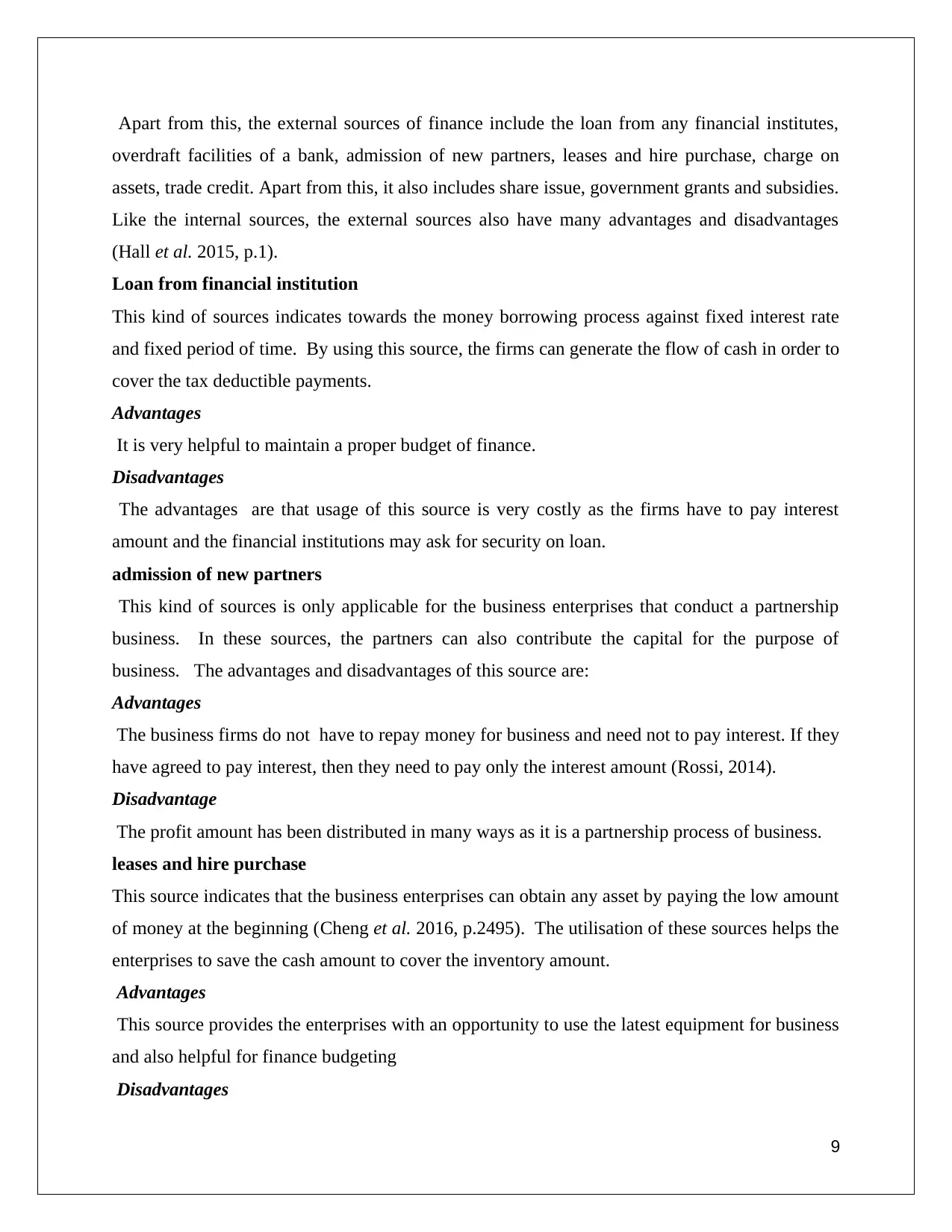
Apart from this, the external sources of finance include the loan from any financial institutes,
overdraft facilities of a bank, admission of new partners, leases and hire purchase, charge on
assets, trade credit. Apart from this, it also includes share issue, government grants and subsidies.
Like the internal sources, the external sources also have many advantages and disadvantages
(Hall et al. 2015, p.1).
Loan from financial institution
This kind of sources indicates towards the money borrowing process against fixed interest rate
and fixed period of time. By using this source, the firms can generate the flow of cash in order to
cover the tax deductible payments.
Advantages
It is very helpful to maintain a proper budget of finance.
Disadvantages
The advantages are that usage of this source is very costly as the firms have to pay interest
amount and the financial institutions may ask for security on loan.
admission of new partners
This kind of sources is only applicable for the business enterprises that conduct a partnership
business. In these sources, the partners can also contribute the capital for the purpose of
business. The advantages and disadvantages of this source are:
Advantages
The business firms do not have to repay money for business and need not to pay interest. If they
have agreed to pay interest, then they need to pay only the interest amount (Rossi, 2014).
Disadvantage
The profit amount has been distributed in many ways as it is a partnership process of business.
leases and hire purchase
This source indicates that the business enterprises can obtain any asset by paying the low amount
of money at the beginning (Cheng et al. 2016, p.2495). The utilisation of these sources helps the
enterprises to save the cash amount to cover the inventory amount.
Advantages
This source provides the enterprises with an opportunity to use the latest equipment for business
and also helpful for finance budgeting
Disadvantages
9
overdraft facilities of a bank, admission of new partners, leases and hire purchase, charge on
assets, trade credit. Apart from this, it also includes share issue, government grants and subsidies.
Like the internal sources, the external sources also have many advantages and disadvantages
(Hall et al. 2015, p.1).
Loan from financial institution
This kind of sources indicates towards the money borrowing process against fixed interest rate
and fixed period of time. By using this source, the firms can generate the flow of cash in order to
cover the tax deductible payments.
Advantages
It is very helpful to maintain a proper budget of finance.
Disadvantages
The advantages are that usage of this source is very costly as the firms have to pay interest
amount and the financial institutions may ask for security on loan.
admission of new partners
This kind of sources is only applicable for the business enterprises that conduct a partnership
business. In these sources, the partners can also contribute the capital for the purpose of
business. The advantages and disadvantages of this source are:
Advantages
The business firms do not have to repay money for business and need not to pay interest. If they
have agreed to pay interest, then they need to pay only the interest amount (Rossi, 2014).
Disadvantage
The profit amount has been distributed in many ways as it is a partnership process of business.
leases and hire purchase
This source indicates that the business enterprises can obtain any asset by paying the low amount
of money at the beginning (Cheng et al. 2016, p.2495). The utilisation of these sources helps the
enterprises to save the cash amount to cover the inventory amount.
Advantages
This source provides the enterprises with an opportunity to use the latest equipment for business
and also helpful for finance budgeting
Disadvantages
9
⊘ This is a preview!⊘
Do you want full access?
Subscribe today to unlock all pages.

Trusted by 1+ million students worldwide
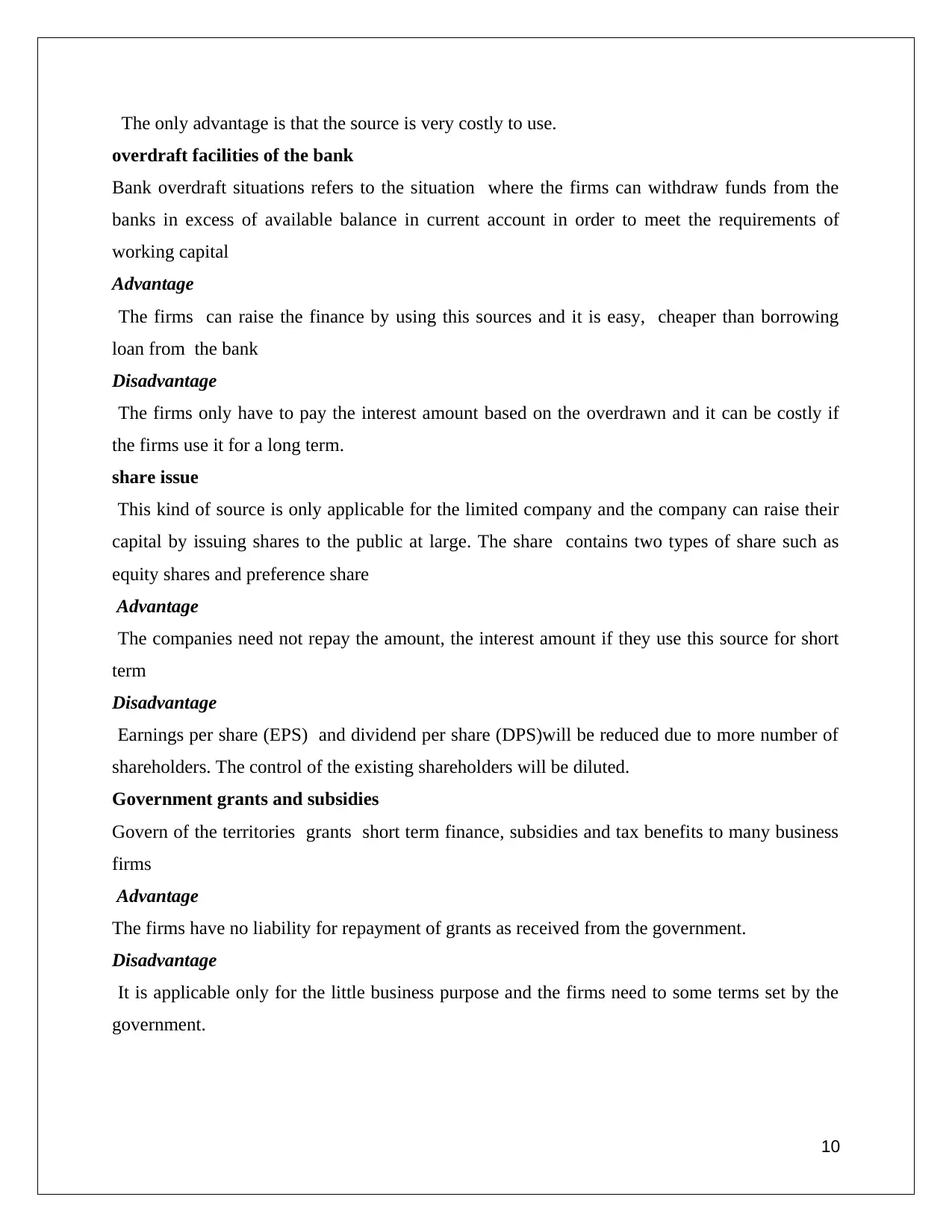
The only advantage is that the source is very costly to use.
overdraft facilities of the bank
Bank overdraft situations refers to the situation where the firms can withdraw funds from the
banks in excess of available balance in current account in order to meet the requirements of
working capital
Advantage
The firms can raise the finance by using this sources and it is easy, cheaper than borrowing
loan from the bank
Disadvantage
The firms only have to pay the interest amount based on the overdrawn and it can be costly if
the firms use it for a long term.
share issue
This kind of source is only applicable for the limited company and the company can raise their
capital by issuing shares to the public at large. The share contains two types of share such as
equity shares and preference share
Advantage
The companies need not repay the amount, the interest amount if they use this source for short
term
Disadvantage
Earnings per share (EPS) and dividend per share (DPS)will be reduced due to more number of
shareholders. The control of the existing shareholders will be diluted.
Government grants and subsidies
Govern of the territories grants short term finance, subsidies and tax benefits to many business
firms
Advantage
The firms have no liability for repayment of grants as received from the government.
Disadvantage
It is applicable only for the little business purpose and the firms need to some terms set by the
government.
10
overdraft facilities of the bank
Bank overdraft situations refers to the situation where the firms can withdraw funds from the
banks in excess of available balance in current account in order to meet the requirements of
working capital
Advantage
The firms can raise the finance by using this sources and it is easy, cheaper than borrowing
loan from the bank
Disadvantage
The firms only have to pay the interest amount based on the overdrawn and it can be costly if
the firms use it for a long term.
share issue
This kind of source is only applicable for the limited company and the company can raise their
capital by issuing shares to the public at large. The share contains two types of share such as
equity shares and preference share
Advantage
The companies need not repay the amount, the interest amount if they use this source for short
term
Disadvantage
Earnings per share (EPS) and dividend per share (DPS)will be reduced due to more number of
shareholders. The control of the existing shareholders will be diluted.
Government grants and subsidies
Govern of the territories grants short term finance, subsidies and tax benefits to many business
firms
Advantage
The firms have no liability for repayment of grants as received from the government.
Disadvantage
It is applicable only for the little business purpose and the firms need to some terms set by the
government.
10
Paraphrase This Document
Need a fresh take? Get an instant paraphrase of this document with our AI Paraphraser

1.3 Identify the most suitable source of finance for the company Clariton
Antiques Limited.
Since the company has, a lower and also a favourable debt-equity ratio of less than 2:1 it can be
said that Clariton Antiques Limited has the option to go with debt financing as then it would be
able to operate on a favourable financial leverage and be able to facilitate trading on equity.
Task 2
2.1 Analysing the costs of the two sources of finance considering the factors of
Tax, Dividends and Interest.
Please refer to the below screenshot for the above solution
From the above screenshot it is visible that the company has a much higher cost of capital in case
the expansion is financed by the venture capitalists as compared to the use of the finance broker,
due to the reason of tax benefit on the Term loan.
2.2 Explaining the benefits of financial planning for the entity Clariton
Antiques Limited.
The importance of the financial planning can be explained as under:
1. Budgeting: Budgeting can be referred to as the technique of setting of the standards
utilising which the actual performance will ba measured and planned accordingly.
Budgeting also helps the business to facilitate the early forecasting of the activities of the
business on the financial statements (Agarwal et al. 2015, p.4).
2. Overtrading: Overtrading can be described as the technique of expanding the business
beyond its capacity. The overtrading needs to be controlled in order to control the
revenue loss in disguise.
11
Antiques Limited.
Since the company has, a lower and also a favourable debt-equity ratio of less than 2:1 it can be
said that Clariton Antiques Limited has the option to go with debt financing as then it would be
able to operate on a favourable financial leverage and be able to facilitate trading on equity.
Task 2
2.1 Analysing the costs of the two sources of finance considering the factors of
Tax, Dividends and Interest.
Please refer to the below screenshot for the above solution
From the above screenshot it is visible that the company has a much higher cost of capital in case
the expansion is financed by the venture capitalists as compared to the use of the finance broker,
due to the reason of tax benefit on the Term loan.
2.2 Explaining the benefits of financial planning for the entity Clariton
Antiques Limited.
The importance of the financial planning can be explained as under:
1. Budgeting: Budgeting can be referred to as the technique of setting of the standards
utilising which the actual performance will ba measured and planned accordingly.
Budgeting also helps the business to facilitate the early forecasting of the activities of the
business on the financial statements (Agarwal et al. 2015, p.4).
2. Overtrading: Overtrading can be described as the technique of expanding the business
beyond its capacity. The overtrading needs to be controlled in order to control the
revenue loss in disguise.
11
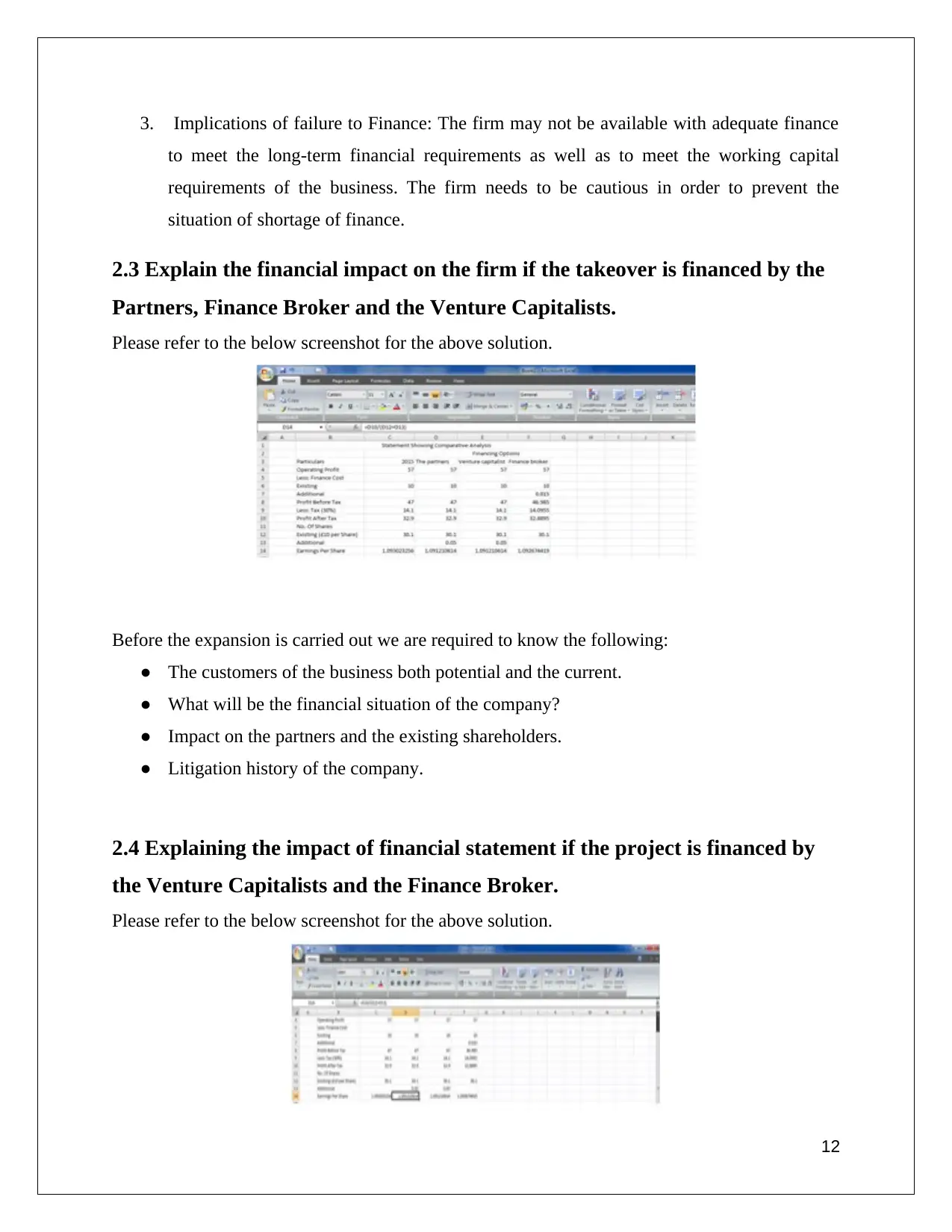
3. Implications of failure to Finance: The firm may not be available with adequate finance
to meet the long-term financial requirements as well as to meet the working capital
requirements of the business. The firm needs to be cautious in order to prevent the
situation of shortage of finance.
2.3 Explain the financial impact on the firm if the takeover is financed by the
Partners, Finance Broker and the Venture Capitalists.
Please refer to the below screenshot for the above solution.
Before the expansion is carried out we are required to know the following:
● The customers of the business both potential and the current.
● What will be the financial situation of the company?
● Impact on the partners and the existing shareholders.
● Litigation history of the company.
2.4 Explaining the impact of financial statement if the project is financed by
the Venture Capitalists and the Finance Broker.
Please refer to the below screenshot for the above solution.
12
to meet the long-term financial requirements as well as to meet the working capital
requirements of the business. The firm needs to be cautious in order to prevent the
situation of shortage of finance.
2.3 Explain the financial impact on the firm if the takeover is financed by the
Partners, Finance Broker and the Venture Capitalists.
Please refer to the below screenshot for the above solution.
Before the expansion is carried out we are required to know the following:
● The customers of the business both potential and the current.
● What will be the financial situation of the company?
● Impact on the partners and the existing shareholders.
● Litigation history of the company.
2.4 Explaining the impact of financial statement if the project is financed by
the Venture Capitalists and the Finance Broker.
Please refer to the below screenshot for the above solution.
12
⊘ This is a preview!⊘
Do you want full access?
Subscribe today to unlock all pages.

Trusted by 1+ million students worldwide
1 out of 20
Related Documents
Your All-in-One AI-Powered Toolkit for Academic Success.
+13062052269
info@desklib.com
Available 24*7 on WhatsApp / Email
![[object Object]](/_next/static/media/star-bottom.7253800d.svg)
Unlock your academic potential
Copyright © 2020–2025 A2Z Services. All Rights Reserved. Developed and managed by ZUCOL.





